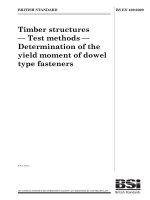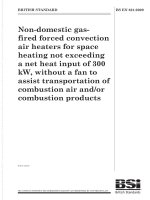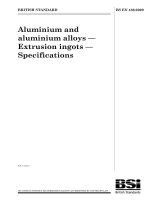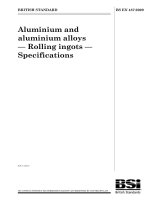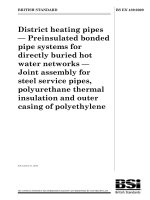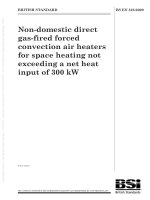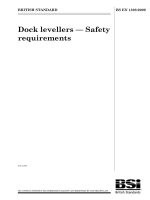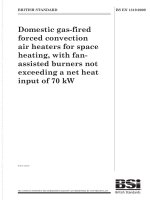Bsi bs en 62110 2009
Bạn đang xem bản rút gọn của tài liệu. Xem và tải ngay bản đầy đủ của tài liệu tại đây (3.16 MB, 54 trang )
BS EN 62110:2009
BSI Standards Publication
Electric and magnetic field
levels generated by AC
power systems —
Measurement procedures
with regard to public
exposure
NO COPYING WITHOUT BSI PERMISSION EXCEPT AS PERMITTED BY COPYRIGHT LAW
raising standards worldwide™
BRITISH STANDARD
BS EN 62110:2009
National foreword
This British Standard is the UK implementation of EN 62110:2009. It is
identical to IEC 62110:2009.
The UK participation in its preparation was entrusted to Technical Committee
GEL/106, Human exposure to low frequency and high frequency
electromagnetic radiation.
A list of organizations represented on this committee can be obtained on
request to its secretary.
This publication does not purport to include all the necessary provisions of a
contract. Users are responsible for its correct application.
© BSI 2010
ISBN 978 0 580 71375 0
ICS 17.220.20; 29.240.01
Compliance with a British Standard cannot confer immunity from
legal obligations.
This British Standard was published under the authority of the Standards
Policy and Strategy Committee on 31 May 2010.
Amendments issued since publication
Amd. No.
Date
Text affected
BS EN 62110:2009
EUROPEAN STANDARD
EN 62110
NORME EUROPÉENNE
December 2009
EUROPÄISCHE NORM
ICS 17.220.20; 29.240
English version
Electric and magnetic field levels generated by AC power systems Measurement procedures with regard to public exposure
(IEC 62110:2009)
Champs électriques et magnétiques
générés par les systèmes d'alimentation
à courant alternatif Procédures de mesure des niveaux
d'exposition du public
(CEI 62110:2009)
Magnetische Felder,
die von WechselstromEnergieversorgungssystemen erzeugt
werden Messverfahren im Hinblick
auf die Exposition
der Allgemeinbevölkerung
(IEC 62110:2009)
This European Standard was approved by CENELEC on 2009-11-01. CENELEC members are bound to comply
with the CEN/CENELEC Internal Regulations which stipulate the conditions for giving this European Standard
the status of a national standard without any alteration.
Up-to-date lists and bibliographical references concerning such national standards may be obtained on
application to the Central Secretariat or to any CENELEC member.
This European Standard exists in three official versions (English, French, German). A version in any other
language made by translation under the responsibility of a CENELEC member into its own language and notified
to the Central Secretariat has the same status as the official versions.
CENELEC members are the national electrotechnical committees of Austria, Belgium, Bulgaria, Cyprus, the
Czech Republic, Denmark, Estonia, Finland, France, Germany, Greece, Hungary, Iceland, Ireland, Italy, Latvia,
Lithuania, Luxembourg, Malta, the Netherlands, Norway, Poland, Portugal, Romania, Slovakia, Slovenia, Spain,
Sweden, Switzerland and the United Kingdom.
CENELEC
European Committee for Electrotechnical Standardization
Comité Européen de Normalisation Electrotechnique
Europäisches Komitee für Elektrotechnische Normung
Central Secretariat: Avenue Marnix 17, B - 1000 Brussels
© 2009 CENELEC -
All rights of exploitation in any form and by any means reserved worldwide for CENELEC members.
Ref. No. EN 62110:2009 E
BS EN 62110:2009
EN 62110:2009
-2-
Foreword
The text of document 106/177/FDIS, future edition 1 of IEC 62110, prepared by IEC TC 106, Methods for
the assessment of electric, magnetic and electromagnetic fields associated with human exposure, was
submitted to the IEC-CENELEC parallel vote and was approved by CENELEC as EN 62110 on
2009-11-01.
The following dates were fixed:
– latest date by which the EN has to be implemented
at national level by publication of an identical
national standard or by endorsement
(dop)
2010-08-01
– latest date by which the national standards conflicting
with the EN have to be withdrawn
(dow)
2012-11-01
Terms defined in Clause 3 appear in italics throughout the document.
Annex ZA has been added by CENELEC.
__________
Endorsement notice
The text of the International Standard IEC 62110:2009 was approved by CENELEC as a European
Standard without any modification.
In the official version, for Bibliography, the following note has to be added for the standard indicated:
IEC 61000-2-2
NOTE Harmonized as EN 61000-2-2:2002 (not modified).
__________
BS EN 62110:2009
-3-
EN 62110:2009
Annex ZA
(normative)
Normative references to international publications
with their corresponding European publications
The following referenced documents are indispensable for the application of this document. For dated
references, only the edition cited applies. For undated references, the latest edition of the referenced
document (including any amendments) applies.
NOTE When an international publication has been modified by common modifications, indicated by (mod), the relevant EN/HD
applies.
Publication
IEC 61786
1)
Undated reference.
Year
-
1)
Title
EN/HD
Measurement of low-frequency magnetic and
electric fields with regard to exposure of human
beings - Special requirements for instruments
and guidance for measurement
Year
-
BS EN 62110:2009
–2–
62110 © IEC:2009
CONTENTS
INTRODUCTION.....................................................................................................................7
1
Scope ...............................................................................................................................8
2
Normative reference .........................................................................................................8
3
Terms and definitions .......................................................................................................8
4
Measurement principle for electric and magnetic fields .....................................................9
4.1
4.2
4.3
4.4
4.5
5
6
7
General ...................................................................................................................9
Instruments .............................................................................................................9
Harmonic content .................................................................................................. 10
Record of measurement result............................................................................... 10
Measurement considerations ................................................................................. 11
4.5.1 Field orientation......................................................................................... 11
4.5.2 Measurement locations .............................................................................. 12
4.5.3 Perturbing effects of an operator in electric field measurement .................. 12
4.5.4 Effects from other sources in magnetic field measurement ........................ 12
4.5.5 Humidity condition in electric field measurement ....................................... 12
Fundamental measurement procedures for electric and magnetic fields.......................... 12
5.1 General procedure ................................................................................................ 12
5.2 Single-point measurement ..................................................................................... 13
5.3 Three-point measurement...................................................................................... 13
5.4 Five-point measurement ........................................................................................ 14
Measurement procedures for finding the maximum exposure level to an electric
field ................................................................................................................................ 15
6.1 Overhead lines ...................................................................................................... 15
6.2 Underground cables .............................................................................................. 15
6.3 Substations and power system equipment ............................................................. 15
Measurement procedures for finding the maximum exposure level to a magnetic
field ................................................................................................................................ 16
7.1 Overhead lines ...................................................................................................... 16
7.2 Underground cables .............................................................................................. 16
7.3 Substations and power system equipment ............................................................. 16
Annex A (informative) Characteristics of electric fields generated by AC overhead
lines...................................................................................................................................... 18
Annex B (informative) Characteristics of magnetic fields generated by AC power
systems ................................................................................................................................ 30
Annex C (informative) Concept of the three-point measurement with regard to the
average exposure level ......................................................................................................... 42
Annex D (informative)
Example of a reporting form for field measurement .......................... 47
Bibliography.......................................................................................................................... 50
Figure 1 – Heights of the three-point measurement ............................................................... 13
Figure 2 – Five-point measurement....................................................................................... 14
Figure A.1 – Linear charge distribution above ground ........................................................... 19
Figure A.2 – General n-phase system with ground ................................................................ 20
Figure A.3 – Electric field levels under an overhead transmission line................................... 22
BS EN 62110:2009
62110 © IEC:2009
–3–
Figure A.4 – Electric field levels under an overhead transmission line with bundled
conductors ............................................................................................................................ 22
Figure A.5 – Electric field levels and non-uniformity under a 77 kV overhead
transmission line – Effect of heights of conductors ................................................................ 24
Figure A.6 – Electric field levels and non-uniformity under a 500 kV overhead
transmission line – Effects of the heights of conductors ........................................................ 25
Figure A.7 – Electric field levels under a 77 kV overhead transmission line – Effect of
separation between conductors............................................................................................. 26
Figure A.8 – Electric field levels and non-uniformity under a 500 kV overhead
transmission line – Effect of separation between conductors................................................. 27
Figure A.9 – Vertical and horizontal components of electric field levels under a 77 kV
overhead transmission line ................................................................................................... 27
Figure A.10 – Vertical and horizontal components of electric field levels under a
500 kV overhead transmission line........................................................................................ 28
Figure A.11 – Electric field contour of a 25 kV overhead line................................................. 28
Figure A.12 – Electric field profile along the wall of a building and at 1 m above ground
level...................................................................................................................................... 29
Figure B.1 – Magnetic field levels under a 77 kV overhead transmission line ........................ 32
Figure B.2 – Magnetic field levels under a 500 kV overhead transmission line ...................... 33
Figure B.3 – Magnetic field levels and non-uniformity under a 77 kV overhead
transmission line – Effect of heights of conductors ................................................................ 34
Figure B.4 – Magnetic field levels and non-uniformity under a 500 kV overhead
transmission line – Effect of heights of conductors ................................................................ 35
Figure B.5 – Magnetic field levels and non-uniformity under a 77 kV overhead
transmission line – Effect of separation between conductors................................................. 36
Figure B.6 – Magnetic field levels under a 500 kV overhead transmission line – Effect
of separation between conductors......................................................................................... 37
Figure B.7 – Values of semi-major and semi-minor components (r.m.s.) of magnetic
field levels under a 77 kV overhead transmission line ........................................................... 38
Figure B.8 – Values of semi-major and semi-minor components (r.m.s.) of magnetic
field levels under a 500 kV overhead transmission line ......................................................... 38
Figure B.9 – Magnetic field levels and non-uniformity under an overhead distribution
line (6 600 V / 100 V) ............................................................................................................ 39
Figure B.10 – Magnetic field levels and non-uniformity above underground cables –
Effect of buried depth ........................................................................................................... 40
Figure B.11 – Magnetic field levels and non-uniformity above underground cables –
Effect of separation between conductors............................................................................... 40
Figure B.12 – Measured magnetic field levels and non-uniformity around a 6 600 V
pad-mounted transformer ...................................................................................................... 41
Figure B.13 – Measured magnetic field levels and non-uniformity around 6 600 V
vertical cables....................................................................................................................... 41
Figure C.1 – A spheroidal human model ............................................................................... 42
Figure C.2 – The model in the magnetic field generated by a straight cable .......................... 43
Figure C.3 – Magnetic field levels generated by a straight cable ........................................... 43
Figure C.4 – The model in the magnetic field generated by three parallel cables .................. 44
Figure C.5 – Magnetic field levels generated by three balanced parallel cables .................... 44
Figure C.6 – The model in the magnetic field generated by underground cables ................... 45
Figure C.7 – Magnetic field levels generated by underground cables .................................... 45
Figure C.8 – The model in the magnetic field generated by overhead wires .......................... 46
BS EN 62110:2009
–4–
62110 © IEC:2009
Figure C.9 – Magnetic field levels generated by balanced overhead wires ............................ 46
BS EN 62110:2009
62110 © IEC:2009
–7–
INTRODUCTION
All populations of the world are now exposed to electric and magnetic fields and the levels will
continue to increase with developing industry and technology. A number of countries have
implemented regulations on public exposure to these fields. Therefore, in order to evaluate
human exposure levels to these fields adequately, common measurement procedures are
required by not only professionals of national authorities and electric power industries, but
also the general public.
This standard is applied to the measurement of fields generated by AC power systems in
areas accessible to the public. It establishes a common measurement procedure to evaluate
the exposure levels of the human body to electric and magnetic fields among the general
public.
The values obtained are for use to determine whether the fields comply with exposure limits
by comparing them with the field limits for general public exposure such as the reference
levels from the ICNIRP (International Commission on Non-Ionizing Radiation Protection)
Guidelines [1] 1) , MPE (maximum permissible exposure) from the IEEE (Institute of Electrical
and Electronics Engineers) [2] or in national regulations. If the values obtained are higher
than the reference level or MPE, it does not necessarily mean that the basic restriction has
been exceeded, in which case other methods must be used to ensure that basic restriction is
not exceeded.
The values obtained by using the procedures in this standard are for the load conditions
occurring at the time of measurement. Therefore, in the case of magnetic field, in order to
check compliance with some exposure guidelines or regulations these values may need to be
extrapolated to take account of the maximum load of the circuits.
This standard is not applicable to occupational exposure associated with, for example, the
operation and/or maintenance of the power systems. Such exposure may occur when working
inside a distribution or transmission substation, a power plant, in a manhole or a tunnel for
underground cables, or on an overhead line tower or pole.
___________
1) Numbers in square brackets refers to the Bibliography.
BS EN 62110:2009
–8–
62110 © IEC:2009
ELECTRIC AND MAGNETIC FIELD LEVELS GENERATED BY AC POWER
SYSTEMS – MEASUREMENT PROCEDURES
WITH REGARD TO PUBLIC EXPOSURE
1
Scope
This International Standard establishes measurement procedures for electric and magnetic
field levels generated by AC power systems to evaluate the exposure levels of the human
body to these fields. This standard is not applicable to DC power transmission systems.
This International Standard is applicable to public exposure in the domestic environment and
in areas accessible to the public.
This standard specifies fundamental procedures for the measurement of fields, and, with
regard to human exposure, for obtaining a field value that corresponds to a spatial average
over the entire human body.
This standard is not applicable to occupational exposure associated with, for example, the
operation and/or maintenance of the power systems. Such exposure may occur when working
inside a distribution or transmission substation, a power plant, in a manhole or a tunnel for
underground cables, or on an overhead line tower or pole.
2
Normative references
The following referenced documents are indispensable for the application of this document.
For dated references, only the edition cited applies. For undated references, the latest edition
of the referenced document (including any amendments) applies.
IEC 61786, Measurement of low-frequency magnetic and electric fields with regard to
exposure of human beings – Special requirements for instruments and guidance for
measurements
3
Terms and definitions
For the purposes of this document, the following terms and definitions given below apply.
Internationally accepted SI-units are used throughout the standard.
NOTE The distinction between “magnetic flux density” and “magnetic field strength” is only relevant when
considering magnetic fields in magnetic materials. In air it is common to use “magnetic fields” as a generic term to
cover both of these two quantities.
3.1
single-point measurement
procedure to measure the field level at a specified height, used for uniform fields
NOTE
The conditions under which the field can be considered as uniform or non-uniform are given in section 5.1.
3.2
three-point measurement
procedure to measure the field levels at three specified heights at a single location, used for
non-uniform fields
BS EN 62110:2009
62110 © IEC:2009
–9–
3.3
five-point measurement
procedure to measure the field levels at five points at a specified height, used for non-uniform
fields generated by field sources below the floor or the ground
3.4
average exposure level
spatial average over the entire human body of fields to which the individual is exposed
3.5
three-point average exposure level
arithmetic mean of the three values obtained from the three-point measurement or of the
largest three values obtained from the five-point measurement
NOTE
This arithmetic mean is used as an estimate of the average exposure level at a single location.
3.6
maximum exposure level
the maximum of the single-point measurements or average exposure levels over the area of
interest
3.7
power system
system consisting of overhead lines and underground cables, substations and other power
distribution and transmission equipment. Railway systems are covered by a specific standard
and therefore are excluded from the present standard.
4
Measurement principle for electric and magnetic fields
4.1
General
Detailed generic information and requirements regarding measurement of electric and
magnetic fields are given in IEC 61786 and in other technical documents such as CIGRE
technical brochures [6][8] and IEEE guides [7][9].
4.2
Instruments
Instruments for measuring electric and magnetic fields shall meet the requirements regarding
calibration and specification given in IEC 61786 or another appropriate national or
international standard. These instruments should be used under appropriate conditions,
particularly with regard to electromagnetic immunity, temperature, and humidity,
recommended by the manufacturer.
A three-axis instrument measures r.m.s. values of resultant field F r . A single-axis instrument
can be used to obtain F r by measuring F x , F y , and F z, using Equation (1).
2
2
Fr = Fx + Fy + Fz
2
(1)
where
F x , F y , and F z are r.m.s. values of the orthogonal three-axis components of electric or
magnetic fields.
When the field has no harmonics, F r can also be obtained by measuring F max and F min , and
then using Equation (2).
BS EN 62110:2009
– 10 –
Fr =
62110 © IEC:2009
Fmax 2 + Fmin 2
(2)
where
F max
is the maximum r.m.s. value of the semi-major axis of the field ellipse;
F min
is the minimum r.m.s. value of the semi-minor axis of the field ellipse.
4.3
Harmonic content
Harmonics are generally caused by non-linear equipment. Harmonics may be present on
transmission lines and on distribution lines. Generally, the total harmonic voltage distortion of
AC power distribution systems (see [3][4]) is low enough to not significantly affect the
exposure, and so it is normally not necessary to quantify the harmonic content. AC
transmission systems have lower harmonic contents.
Where there is significant concern that the harmonic content of fields cannot be ignored,
existing methods of assessing the field harmonic content should be used following IEC 61786
for measurement. The assessment of the fields taking account of the harmonic frequencies
should be evaluated according to the procedure specified in the safety standard (e.g. [5]) to
be applied.
4.4
Record of measurement result
In the measurement report, the following information should be recorded:
–
date, time, and weather conditions (e.g. sunny, rain, snow and wind conditions) when the
measurement is carried out;
–
temperature and humidity (for electric field measurement);
–
type (overhead line, cable, substation, etc.) and nominal voltage of the power system,
configuration and phase arrangement of overhead conductors and/or underground cables
that generate the measured fields, if available;
–
information on instruments [instrument manufacturer, model, probe size and geometry,
type of probe or meter (free-body meter, ground reference meter, fluxgate meter, coil
probe, Hall effect probe), magnitude range, pass bandwidth, latest calibrated date], if
available;
–
estimation of the uncertainty of measurement;
NOTE 1
Measurement uncertainty can be estimated using a procedure proposed by, e.g., IEC 61786.
–
person/company who performs the measurement;
–
height(s) above the ground or the floor where the measurement is performed;
–
measurement location related to the power systems of interest;
–
measurement location in the room when the measurement is carried out in a building;
–
measured field (electric or magnetic) levels;
–
clear indication of what field quantity is being reported, for example, resultant field, r.m.s.
values of each orthogonal three-axis component of the field or maximum or minimum r.m.s.
values of the semi-major or semi-minor axis of the field;
–
type, spatial position, and operating condition of other field sources near the measurement
point;
–
sketch and/or photograph of the measurement site with measurement location and other
field sources;
–
type, sort of material, dimensions and spatial position of permanent and removable objects
for electric field measurement;
–
type, sort of material, dimensions and spatial position of permanent and removable objects
that contain magnetic materials or non-magnetic conductors for magnetic field
measurement;
BS EN 62110:2009
62110 © IEC:2009
–
– 11 –
current values flowing when magnetic field measurement is carried out, if possible and
relevant;
NOTE 2 There might be some cases in which these load values would be difficult to obtain. Moreover, for low
voltage distribution systems, the net current can be the more relevant parameter.
NOTE 3 One possible way to survey the variation of the load is to use a second magnetic field meter at a fixed
position (see [6]).
–
harmonic contents, if significant.
The above information is important when the measurement results are compared with the
calculated levels and/or other measurement results.
An example of a measurement report is given in Annex D.
4.5
Measurement considerations
4.5.1
4.5.1.1
Field orientation
Electric field
Electric field measurement instruments are either single-axis or three-axis. The latter is the
preferred option.
The electric field adjacent to a conducting surface is normal to the surface, Therefore, the
horizontal component of the electric field, particularly where it is generated by overhead lines,
can be ignored close to the ground surface. Single-axis measurement (vertical component) is
therefore sufficient near the ground. Some examples of calculated electric field levels at a
height of 1,0 m above the ground under overhead lines are shown in A.3.3. These
demonstrate that at 1,0 m above the ground, the vertical component is similar to the resultant
(see Figures A.9 and A.10).
Particular care must be taken in the presence of conducting objects (see 4.5.2.1) or when the
clearance of the conductor from the ground is small.
4.5.1.2
Magnetic field
Magnetic field measurements should be made with three-axis instruments and should be of
the resultant field, except where there is a particular reason for using single-axis instruments.
Reasons for using single-axis instruments include the desire to know the direction of the field
and the maximum r.m.s. value of the semi-major axis of the field ellipse, the wish to
investigate the orientation and shape of the magnetic field ellipse, and cases when the
direction of a linearly polarised field is already known; however, these are not covered by this
standard.
When a suitable three-axis instrument is not available, a single-axis instrument may be used
to determine the resultant field using Equation (1) or Equation (2), provided that the field level
remains stable during the time taken to perform the measurements. In this case, use of a
fixture made from non-conducting materials for orienting the probe in three orthogonal
directions will expedite the measurement process.
NOTE Three-axis instruments often measure the three components sequentially which should be taken into
account when field is changing.
Generally, the r.m.s. value of the semi-minor axis of the field ellipse under transmission lines
is significantly smaller than that of the semi-major axis. Single-axis instruments may be used
in such a case (see B.3.3).
BS EN 62110:2009
– 12 –
4.5.2
62110 © IEC:2009
Measurement locations
4.5.2.1
Electric field
In order to take electric field level measurements representing the unperturbed field at a given
location, the area should be free as far as possible from other power lines, towers, trees,
fences, tall grass, or other irregularities. It is preferred that the location should be relatively
flat. It should be noted that the influence of vegetation on the electric field level can be
significant. In general, field enhancement occurs above individual items of vegetation and
field attenuation occurs near the sides. Field perturbation can depend markedly on the water
content in the vegetation.
All movable objects should be removed when possible. If not, then the distance between the
probe and the object should be more than three times the height of the object (non-permanent
object) or 1,0 m (permanent object) [6].
If these recommendations cannot be fulfilled, it should be clearly noted on the measurement
report.
4.5.2.2
Magnetic field
Non-permanent objects containing magnetic materials or nonmagnetic conductors should be
at least three times the largest dimensions of the object away from the point of measurement
in order to measure the unperturbed field value. The distance between the probe and
permanent magnetic objects should not be less than 1,0 m in order to accurately measure the
ambient unperturbed field [7].
If these recommendations cannot be fulfilled, it should be clearly noted on the measurement
report.
4.5.3
Perturbing effects of an operator in electric field measurement
To reduce perturbation of a measured electric field, the distance between the electric field
measurement instrument and the operator should be at least 1,5 m and 3 m should be
recommended [6]. This can be achieved using a fibre optic cable between the monitor and the
probe with the latter on a non-conductive support.
4.5.4
Effects from other sources in magnetic field measurement
Magnetic field sources other than power systems near the measurement point should be
turned off or removed, if possible, to minimise their influence on the measurement result. If it
is difficult to turn off or remove the sources, relevant information about them, for example,
type of source, location relative to the measurement point, etc. should be recorded.
4.5.5
Humidity condition in electric field measurement
Electric field measurement may be perturbed if the relative humidity is more than 70 % due to
condensation effect on the probe and support [6]. Since the effect of humidity depends on the
field meter, the ability of the field meter to work correctly under those conditions should be
checked before measurement.
5
5.1
Fundamental measurement procedures for electric and magnetic fields
General procedure
Different procedures are specified here that use single-, three- or five-point measurement. If
the values obtained are all below the reference level or MPE, no further processing is
necessary for demonstration of compliance.
BS EN 62110:2009
62110 © IEC:2009
– 13 –
When measuring field levels under overhead lines, the field near the ground is considered to
be uniform (see justification in B.3.2.1); therefore, single-point measurements are sufficient.
Other situations such as public areas adjacent to underground cables, indoor substations, etc.
are considered to be non-uniform and three- or five- point measurement shall be used as
appropriate.
5.2
Single-point measurement
Where the field is considered to be uniform, the electric or magnetic field level at the point of
interest should be measured at 1,0 m above the ground or the floor in the building. This
measured level is recognised as the average exposure level (see Annexes A and B).
If necessary, other heights may be used, in which case the actual measurement height should
be explicitly recorded in the measurement report.
5.3
Three-point measurement
Where the field is considered to be non-uniform, the electric and magnetic field level at the
position of interest should be measured at the three heights, 0,5 m, 1,0 m, and 1,5 m above
the ground or floor level in a building. Beside power equipment or in a building, measurement
should be performed at a horizontal distance of 0,2 m from its surface or boundary or a wall.
In situations where the equipment has a height less than 1,5 m, the three-point measurements
must be performed at equidistant heights with the highest being at the same height as the top
of the equipment (see Figure 1).
If necessary, other heights may be used, in which case the actual measurement heights
should be explicitly recorded in the measurement report.
NOTE In the case where the safety standard does not allow spatial averaging (such as [2]), then the maximum of
the three measured values should be used.
The three-point average exposure level is recognised as the average exposure level (see
Annex C).
0,2 m
0,2 m
0,5 m
H/3
H
0,5 m
H/3
H
0,5 m
H/3
H < 1,5 m
H ≥ 1,5 m
Measuring points
Figure 1 – Heights of the three-point measurement
IEC
1606/09
BS EN 62110:2009
62110 © IEC:2009
– 14 –
5.4
Five-point measurement
Where there are sources of field below the ground or the floor and there is a reasonable
possibility that a person is likely to lie down above it, a five-point measurement should be
performed as follows.
The level of magnetic field should be scanned at a height of 0,2 m above the ground or the
floor to find the value and the position of the maximum field. The value and the position of the
second maximum field should be scanned on a circle with a radius of 0,5 m centred on the
maximum position. Another measurement should be made at the point that is symmetric to the
second maximum. A further two measurements should be made, along the line perpendicular
to the line passing the former three measurement points, at distances of 0,5 m on either side
of the position of the maximum (see Figure 2.). The average of the largest three of the five
readings shall be calculated. This average is recognised as the average exposure level
NOTE In practice, it may be necessary to adapt the procedure to take account of furniture that cannot be removed
and walls of the room, etc..
In cases where a person is not likely to lie on the ground or the floor, the normal three-point
measurement shall be used.
Second maximum point
The maximum point
P4
0,5 m
P1
0,5 m
0,5 m
0,2 m
0,2 m
2 Second maximum
point (P2)
(The maximum point
on the circumference)
P5
0,5
0,2 m
P3
4 The perpendicular
point (P4)
P2
0,2 m
Scanning
0,5 m
1 The maximum
point (P1)
90°
0,2 m
5 The perpendicular
point (P5)
3 The symmetrical
point (P3)
Measurement points (P1 – P5)
IEC
Measuring
Measured
values Adopted
Measuring
Adopted
Measured values
points
(index)
values
P1
10 μT
X
P2
5 μT
X
P3
1 μT
P4
2 μT
P5
3 μT
NOTE
Three-point average exposure level is;
X
Dotted lines represent the floor or ground level.
Figure 2 – Five-point measurement
(P1 + P2 + P5)
= 6 μT
3
1607/09
BS EN 62110:2009
62110 © IEC:2009
6
6.1
– 15 –
Measurement procedures for finding the maximum exposure level to an
electric field
Overhead lines
The levels of electric field under an overhead line depend on many factors including distance
from conductors, their separation and phase arrangement, and the voltage of the line (see
Annex A).
The largest electric field level is found under conductors at the point on the span where the
conductors are closest to the ground. Therefore, to find the position where the field level is
the maximum, the electric field level should first be measured at 1,0 m above the ground
along the path parallel to the overhead line under conductors where possible at appropriate
intervals (longitudinal profile). Then, to discover whether another peak occurs, measurement
should be performed at 1,0 m above the ground along the path perpendicular to the overhead
line, at the point of the longitudinal profile maximum (lateral profile).
When the position where the field level is a maximum is already known in the area of interest,
a single-point measurement should be performed at that position.
If the area of interest is not oversailed by a conductor, then the process for finding the
maximum exposure level is similar, but the longitudinal profile should be parallel to the line.
There are some references, such as [6] and [7], which give detailed procedures for obtaining
the profiles of electric field levels around an overhead line.
6.2
Underground cables
Underground cables do not produce electric fields above the ground, so measurement of
electric field is not required.
6.3
Substations and power system equipment
With the exception of overhead lines (see 6.1) and substations with overhead lines connected
to the substation, power system equipment does not produce electric fields in areas
accessible to the public, so measurements of electric field are not required.
For substations with overhead lines connected to the substation, the level of electric field
should be measured at a height of 1 m above the ground and at a distance of 0,2 m from the
substation, around substations at appropriate intervals, to find the position where the field
level is the maximum in the area of interest.
At the position where the maximum field level is found, a three-point measurement should be
performed (see 5.3).
When the position of the maximum field within the area of interest is already known, a
three-point measurement should be performed at that position.
For substations, maximum fields usually occur under overhead lines where they enter the
substation. Electric field measurement under these lines should follow the procedure
described in 6.1.
BS EN 62110:2009
– 16 –
7
7.1
62110 © IEC:2009
Measurement procedures for finding the maximum exposure level to a
magnetic field
Overhead lines
The levels of magnetic field level under an overhead line depend on many factors including
distance from conductors, their separation and phase arrangement, and the currents in the
line (see Annex B).
The largest magnetic field is found under conductors at the point on the span where the
conductors are closest to the ground. Therefore, to find the position at which the field level is
the maximum, the magnetic field level should first be measured at 1,0 m above the ground
along the path parallel to the overhead line under conductors where possible at appropriate
intervals (longitudinal profile). Then, to discover whether another peak occurs, measurement
should be performed at 1,0 m above the ground along the path perpendicular to the overhead
line, at the point of the longitudinal profile maximum (lateral profile).
The magnetic field under an overhead line is considered to be uniform (see 5.1).
When a position where the field level would be the maximum is already known in the area of
interest, a single-point measurement should be performed at that position.
If the area of interest is not oversailed by a conductor then the process for finding the
maximum exposure level is similar, but the longitudinal profile should be parallel to the line.
There are some references, such as [6] and [7], which give detailed procedures for obtaining
the profiles of magnetic field levels around an overhead line.
7.2
Underground cables
The level of magnetic field should be measured at a height of 1,0 m above the ground, along
the path considered to be perpendicular to the underground cables, at appropriate intervals
(lateral profile). At the position where the maximum field level is found, a three-point
measurement should be performed (see 5.3).
The magnetic field is approximately constant along underground cables, except in some
special locations such as a splice chamber, joint bay, or change of depth. Such locations can
be found by taking measurements along the cable route, seeking the maximum at a height of
1,0 m (longitudinal profile). At the position where the maximum field level is found, the same
procedure as that described above (lateral profile) should be performed.
If there are particular areas of interest, a measurement using the same procedure as
described above (longitudinal and lateral profile) may be repeated.
When a position where the field level would be the maximum is already known in the area of
interest, a three-point measurement should be performed at that position.
7.3
Substations and power system equipment
The level of magnetic field should be measured at a height of 1,0 m above the ground, around
equipment or substations at a horizontal distance of 0,2 m from its surface or boundary, at
appropriate intervals. In situations where the equipment has a height less than 1,5 m, the
level of magnetic field should be measured at the top height of the equipment instead of 1,0 m.
At the position where the maximum field level is found, a three-point measurement should be
performed (see 5.3).
When the position of the maximum field within the area of interest is already known, a
three-point measurement should be performed at that position.
BS EN 62110:2009
62110 © IEC:2009
– 17 –
For substations, maximum field levels usually occur under overhead lines or above
underground cables where they enter the substation. Magnetic field measurement in these
situations should follow the procedures described in 7.1 and 7.2, respectively.
Locally, higher magnetic field levels may be found closer to the surface of the equipment or to
the boundary of the substation. However, those levels are not considered as representative of
average exposure level of the general public in normal situations.
In cases where the area above an indoor substation is occupied and where a person is likely
to lie on the floor, a five-point measurement should be performed (see 5.4).
In cases where a person is not likely to lie on the floor, the normal three-point measurement
should be performed.
BS EN 62110:2009
– 18 –
62110 © IEC:2009
Annex A
(informative)
Characteristics of electric fields generated by AC overhead lines
A.1
General
In general, it is only higher-voltage overhead lines that produce levels of electric field that
need to be considered. Electric field levels are lower near lower-voltage overhead lines,
distribution equipment, and around substations. Underground cables are shielded, and
therefore produce no external electric field.
This annex shows examples of calculation results of spatial profiles of electric fields
generated by overhead transmission and distribution lines.
A.2
General calculation procedure for electric field level
Electric field strength E at distance r from a linear conductor parallel to the ground with
charge density λ is expressed as
E=
λ 1
2πε 0 r
(A.1)
where
ε0 is permittivity of the vacuum, equal to 8,854 × 10–12 F/m.
To take into account conductivity of the ground, the computation of E at a given point (P) can
be conducted by using the image charge equivalent to −λ at height –h as shown in Figure A.1.
E1 =
1
1
λ
λ
and E2 =
2πε 0 R1
2πε 0 R2
(A.2)
where
E 1 is the electric field strength at point P caused by linear charge λ ;
E 2 is the electric field strength at point P caused by image charge − λ ;
R 1 is the distance of point P from linear charge λ ;
R 2 is the distance of point P from linear charge − λ .
R1 = ( X C − X P )2 + ( h − YP )2
and R2 = ( X C − X P )2 + ( h + YP )2
where
Y P is the height of point P;
X C is the horizontal location of linear charge λ and −λ ;
X P is the horizontal location of point P.
(A.3)
BS EN 62110:2009
62110 © IEC:2009
– 19 –
λ
h
R1
P
YP
E2
E x1
E1
E y1
E
XC
R2
XP
–λ-λ
IEC
1608/09
Figure A.1 – Linear charge distribution above ground
Field vectors E 1 and E 2 can be decomposed as orthogonal components.
E1x = E1
E2 x = − E2
XP − X C
h − YP
and E1y = − E1
R1
R1
(A.4)
XP − XC
h + YP
and E2 y = − E2
R2
R2
(A.5)
Finally, the components of field vector E are
Ex =
λ
2πε 0
⎡ XP − XC
X − XC
− P
⎢
2
R1
R22
⎢⎣
⎤
λ
⎥ and E y = −
2
ε0
π
⎥⎦
⎡ h −Y
⎤
P + h + YP
⎢
⎥
R22 ⎥⎦
⎢⎣ R12
(A.6)
Field strength E at point P is
E = E x2 + E 2y
(A.7)
Potential V at the conductor surface is given by
V=
2h
λ
ln
2πε 0
a
(A.8)
Where a is the radius of the conductor.
In the case of multiple conductors as shown in Figure A.2, Equation (A.8) becomes a matrix.
[P][λ ] = [V ]
(A.9)
BS EN 62110:2009
62110 © IEC:2009
– 20 –
Matrix
[P]
is the potential coefficients matrix where
11
Radius
ii
ri
2
d ij
n
j
hi
Phase conductors
D ij
P
Xj
Image conductors
IEC
1609/09
Figure A.2 – General n-phase system with ground
Pii =
2h
1
ln( i )
ri
2πε 0
Pij =
Dij
1
ln(
)
d ij
2πε 0
for i = 1 to n
(A.10)
for i ≠ j
A.11)
where
n
is the number of conductors;
D ij is the distance between conductor i and the image of the conductor j;
d ij
is the distance between the conductors i and j;
ri
is the radius of conductor i.
When calculating electric field levels under an overhead line, this linear charge distribution
system can be used. For an AC power line, conductor i corresponds to each phase conductor.
When phase conductor i consists of a subconductor bundle, which has the number of
subconductors n b and in which each subconductor is located at each apex of a regular
polygon, r i can be substituted by equivalent geometric radius r ei (see Figure A.4).
1
n −1
⎡
⎛
⎞ b ⎤ nb
S
⎢
⎥
⎟
rei = nb r0 ⎜⎜
⎢
⎥
2 sin(π nb ) ⎟⎠
⎝
⎣
⎦
(A.12)
BS EN 62110:2009
62110 © IEC:2009
– 21 –
where
n b is the number of subconductors,
r 0 is the subconductor radius,
S
is adjacent subconductors spacing.
Charges
λi
can be determined by solving the linear system of equations (A.9).
Components E xi and E yi of the field vector generated by conductor i at point P are
E xi =
λi ⎡ X P − X ci X ci − X P ⎤
−
⎢
⎥
2πε 0 ⎣ R12i
R22i ⎦
and E yi = −
λi ⎡ hi − YP hi + YP ⎤
+
⎢
⎥
2πε 0 ⎣⎢ R12i
R22i ⎦⎥
(A.13
where
λi
X Ci is the horizontal location of linear charge
R1i = ( X ci − X P )2 + ( h i −YP )2
and
− λi ;
and R2i = ( X ci − X P )2 + ( hi + YP )2
(A.14)
For the whole overhead lines, the total components at point P are
n
Ex =
∑
n
E xi and E y =
i =1
A.3
A.3.1
∑ E yi
(A.15)
i =1
Example of electric fields generated by overhead transmission lines
Spatial profiles of an electric field
Figure A.3 shows an example of the spatial profile of the calculated electric field levels
generated by a 77 kV overhead transmission line that has a double-circuit, vertical
configuration. Each conductor has a radius of 12,65 mm. Cases of both the untransposed and
the transposed phase arrangement are considered (see Figure A.3). Electric field levels are
calculated as a function of distance from the centre of the conductors, at a height of 1,0 m
above ground.
BS EN 62110:2009
62110 © IEC:2009
– 22 –
AA
BB
900
Electric
Field (V/m)
900
Electric field (V/m)
800
Phase
phase sequence
sequence
AA
AA
BB
BB
CC
CC
CC
Untransposed
Untransposed
700
CC
BB
3,2 m
3,2 m
3,5 m
3,5 m
3,8 m
3,8 m
3,0 m
AA
Transposed
transposed
3,0 m
600
500
Conductor
400
11,0 m
300
200
100
1,0 m
G.L.
0
–30
-30
–20
-20
–10
-10
0
10
Distance x (m)
20
30
0
distance x (m)
Distance (m)
77 kV, double-circuit, vertical configuration
IEC 1610/09
Figure A.3 – Electric field levels under an overhead transmission line
Figure A.4 shows an example of the spatial profile of the calculated electric field levels
generated by a 500 kV overhead transmission line that has a single-circuit, horizontal
configuration. Each conductor has a radius of 14,25 mm. Electric field levels are calculated as
a function of distance from the centre of the conductors, at a height of 1,0 m above the
ground. Each phase consists of four bundled conductors with radii of 14,25 mm, and the
adjacent conductors spacing of 400 mm. Consequently, the equivalent geometric radius of
189,5 mm, obtained by Equation (A.4) is used for calculation.
Electric field (V/m)
Phase sequence
sequence
phase
10 000
9 000
8 000
7 000
6 000
C
C
B
B
A
A
10,0 m
Conductor
11,0 m
5 000
4 000
3 000
2 000
1 000
0
10,0 m
Subconductors
radius ri
14,25 mm
S 400 mm
S
1,0 m
Equivalent
geometric
radius rei
Substitute
Four bundled
conductors
189,5 mm
Single conductor
G.L.
–30
–20
–10
0
10
20
30
0 Distance (m)
Distance x (m)
500 kV, double-circuit, vertical configuration
IEC 1611/09
Figure A.4 – Electric field levels under an overhead transmission
line with bundled conductors
A.3.2
A.3.2.1
Factors affecting an electric field
Clearance of the lowest conductor from ground
Figure A.5 shows two examples of the spatial profile of the calculated electric field levels
generated by a 77 kV overhead transmission line that has a double-circuit, vertical
configuration. In one case, the clearance of the lowest conductor from ground is assumed to
be 11,0 m, and in the other, 6,0 m. The cases of both the untransposed and the transposed
phase arrangement are considered. Electric field levels are calculated as a function of
distance from the centre of the conductors, at heights of 0,5 m, 1,0 m, and 1,5 m above
ground. Each conductor has a radius of 12,65 mm.
BS EN 62110:2009
62110 © IEC:2009
– 23 –
Calculated non-uniformity is also shown in the Figure A.5, which is defined as the maximum
value of
( E h − E avg ) / Eavg × 100 (%)
(A.16)
where
Eh is the electric field level at heights of 0,5 m, 1,0 m and 1,5 m above ground;
Eavg is the arithmetic mean of the three levels.
This could be an approximate measure to estimate and to define the non-uniformity of an
electric field.
Figure A.6 shows two examples of the spatial profile of the calculated electric field levels
generated by a 500 kV overhead transmission line that has a single-circuit, horizontal
configuration. Calculated non-uniformity is also shown in the Figure A.6. In one case, the
clearance of the lowest conductor from ground is assumed to be 11,0 m, and in the other,
6,0 m. Electric field levels are calculated as a function of distance from the centre of the
conductors, at heights of 0,5 m, 1,0 m, and 1,5 m above ground. Each phase consists of four
bundled conductors with radii of 14,25 mm, and the adjacent conductors spacing of 400 mm.
Consequently, the equivalent geometric radius of 189,5 mm, obtained by Equation (A.12), is
used for calculation.
